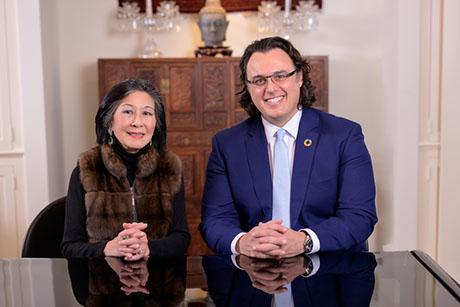Q&A: Climate Grand Challenges finalists on accelerating reductions in global greenhouse gas emissions
This is the second article in a four-part interview series highlighting the work of the 27 MIT Climate Grand Challenges finalists, which received a total of $2.7 million in startup funding to advance their projects. In April, the Institute will name a subset of the finalists as multiyear flagship projects.
Last month, the Intergovernmental Panel on Climate Change (IPCC), an expert body of the United Nations representing 195 governments, released its latest scientific report on the growing threats posed by climate change, and called for drastic reductions in greenhouse gas emissions to avert the most catastrophic outcomes for humanity and natural ecosystems.
Bringing the global economy to net-zero carbon dioxide emissions by midcentury is complex and demands new ideas and novel approaches. The first-ever MIT Climate Grand Challenges competition focuses on four problem areas including removing greenhouse gases from the atmosphere and identifying effective, economic solutions for managing and storing these gases. The other Climate Grand Challenges research themes address using data and science to forecast climate-related risk, decarbonizing complex industries and processes, and building equity and fairness into climate solutions.
In the following conversations prepared for MIT News, faculty from three of the teams working to solve “Removing, managing, and storing greenhouse gases” explain how they are drawing upon geological, biological, chemical, and oceanic processes to develop game-changing techniques for carbon removal, management, and storage. Their responses have been edited for length and clarity.
Directed evolution of biological carbon fixation
Agricultural demand is estimated to increase by 50 percent in the coming decades, while climate change is simultaneously projected to drastically reduce crop yield and predictability, requiring a dramatic acceleration of land clearing. Without immediate intervention, this will have dire impacts on wild habitat, rob the livelihoods of hundreds of millions of subsistence farmers, and create hundreds of gigatons of new emissions. Matthew Shoulders, associate professor in the Department of Chemistry, talks about the working group he is leading in partnership with Ed Boyden, the Y. Eva Tan professor of neurotechnology and Howard Hughes Medical Institute investigator at the McGovern Institute for Brain Research, that aims to massively reduce carbon emissions from agriculture by relieving core biochemical bottlenecks in the photosynthetic process using the most sophisticated synthetic biology available to science.
Q: Describe the two pathways you have identified for improving agricultural productivity and climate resiliency.
A: First, cyanobacteria grow millions of times faster than plants and dozens of times faster than microalgae. Engineering these cyanobacteria as a source of key food products using synthetic biology will enable food production using less land, in a fundamentally more climate-resilient manner. Second, carbon fixation, or the process by which carbon dioxide is incorporated into organic compounds, is the rate-limiting step of photosynthesis and becomes even less efficient under rising temperatures. Enhancements to Rubisco, the enzyme mediating this central process, will both improve crop yields and provide climate resilience to crops needed by 2050. Our team, led by Robbie Wilson and Max Schubert, has created new directed evolution methods tailored for both strategies, and we have already uncovered promising early results. Applying directed evolution to photosynthesis, carbon fixation, and food production has the potential to usher in a second green revolution.
Q: What partners will you need to accelerate the development of your solutions?
A: We have already partnered with leading agriculture institutes with deep experience in plant transformation and field trial capacity, enabling the integration of our improved carbon-dioxide-fixing enzymes into a wide range of crop plants. At the deployment stage, we will be positioned to partner with multiple industry groups to achieve improved agriculture at scale. Partnerships with major seed companies around the world will be key to leverage distribution channels in manufacturing supply chains and networks of farmers, agronomists, and licensed retailers. Support from local governments will also be critical where subsidies for seeds are necessary for farmers to earn a living, such as smallholder and subsistence farming communities. Additionally, our research provides an accessible platform that is capable of enabling and enhancing carbon dioxide sequestration in diverse organisms, extending our sphere of partnership to a wide range of companies interested in industrial microbial applications, including algal and cyanobacterial, and in carbon capture and storage.
Strategies to reduce atmospheric methane
One of the most potent greenhouse gases, methane is emitted by a range of human activities and natural processes that include agriculture and waste management, fossil fuel production, and changing land use practices — with no single dominant source. Together with a diverse group of faculty and researchers from the schools of Humanities, Arts, and Social Sciences; Architecture and Planning; Engineering; and Science; plus the MIT Schwarzman College of Computing, Desiree Plata, associate professor in the Department of Civil and Environmental Engineering, is spearheading the MIT Methane Network, an integrated approach to formulating scalable new technologies, business models, and policy solutions for driving down levels of atmospheric methane.
Q: What is the problem you are trying to solve and why is it a “grand challenge”?
A: Removing methane from the atmosphere, or stopping it from getting there in the first place, could change the rates of global warming in our lifetimes, saving as much as half a degree of warming by 2050. Methane sources are distributed in space and time and tend to be very dilute, making the removal of methane a challenge that pushes the boundaries of contemporary science and engineering capabilities. Because the primary sources of atmospheric methane are linked to our economy and culture — from clearing wetlands for cultivation to natural gas extraction and dairy and meat production — the social and economic implications of a fundamentally changed methane management system are far-reaching. Nevertheless, these problems are tractable and could significantly reduce the effects of climate change in the near term.
Q: What is known about the rapid rise in atmospheric methane and what questions remain unanswered?
A: Tracking atmospheric methane is a challenge in and of itself, but it has become clear that emissions are large, accelerated by human activity, and cause damage right away. While some progress has been made in satellite-based measurements of methane emissions, there is a need to translate that data into actionable solutions. Several key questions remain around improving sensor accuracy and sensor network design to optimize placement, improve response time, and stop leaks with autonomous controls on the ground. Additional questions involve deploying low-level methane oxidation systems and novel catalytic materials at coal mines, dairy barns, and other enriched sources; evaluating the policy strategies and the socioeconomic impacts of new technologies with an eye toward decarbonization pathways; and scaling technology with viable business models that stimulate the economy while reducing greenhouse gas emissions.
Deploying versatile carbon capture technologies and storage at scale
There is growing consensus that simply capturing current carbon dioxide emissions is no longer sufficient — it is equally important to target distributed sources such as the oceans and air where carbon dioxide has accumulated from past emissions. Betar Gallant, the American Bureau of Shipping Career Development Associate Professor of Mechanical Engineering, discusses her work with Bradford Hager, the Cecil and Ida Green Professor of Earth Sciences in the Department of Earth, Atmospheric and Planetary Sciences, and T. Alan Hatton, the Ralph Landau Professor of Chemical Engineering and director of the School of Chemical Engineering Practice, to dramatically advance the portfolio of technologies available for carbon capture and permanent storage at scale. (A team led by Assistant Professor Matěj Peč of EAPS is also addressing carbon capture and storage.)
Q: Carbon capture and storage processes have been around for several decades. What advances are you seeking to make through this project?
A: Today’s capture paradigms are costly, inefficient, and complex. We seek to address this challenge by developing a new generation of capture technologies that operate using renewable energy inputs, are sufficiently versatile to accommodate emerging industrial demands, are adaptive and responsive to varied societal needs, and can be readily deployed to a wider landscape.
New approaches will require the redesign of the entire capture process, necessitating basic science and engineering efforts that are broadly interdisciplinary in nature. At the same time, incumbent technologies have been optimized largely for integration with coal- or natural gas-burning power plants. Future applications must shift away from legacy emitters in the power sector towards hard-to-mitigate sectors such as cement, iron and steel, chemical, and hydrogen production. It will become equally important to develop and optimize systems targeted for much lower concentrations of carbon dioxide, such as in oceans or air. Our effort will expand basic science studies as well as human impacts of storage, including how public engagement and education can alter attitudes toward greater acceptance of carbon dioxide geologic storage.
Q: What are the expected impacts of your proposed solution, both positive and negative?
A: Renewable energy cannot be deployed rapidly enough everywhere, nor can it supplant all emissions sources, nor can it account for past emissions. Carbon capture and storage (CCS) provides a demonstrated method to address emissions that will undoubtedly occur before the transition to low-carbon energy is completed. CCS can succeed even if other strategies fail. It also allows for developing nations, which may need to adopt renewables over longer timescales, to see equitable economic development while avoiding the most harmful climate impacts. And, CCS enables the future viability of many core industries and transportation modes, many of which do not have clear alternatives before 2050, let alone 2040 or 2030.
The perceived risks of potential leakage and earthquakes associated with geologic storage can be minimized by choosing suitable geologic formations for storage. Despite CCS providing a well-understood pathway for removing enough of the carbon dioxide already emitted into the atmosphere, some environmentalists vigorously oppose it, fearing that CCS rewards oil companies and disincentivizes the transition away from fossil fuels. We believe that it is more important to keep in mind the necessity of meeting key climate targets for the sake of the planet, and welcome those who can help.



